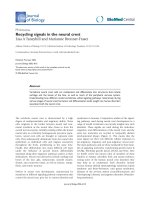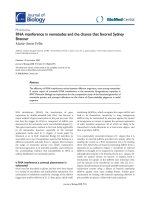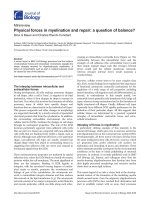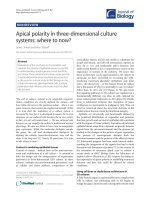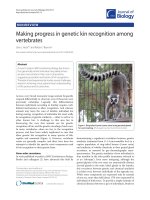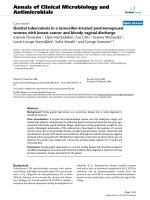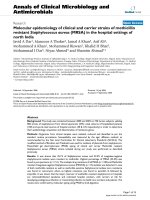Báo cáo sinh học: "RNA interference in nematodes and the chance that favored Sydney Brenner" pot
Bạn đang xem bản rút gọn của tài liệu. Xem và tải ngay bản đầy đủ của tài liệu tại đây (197.35 KB, 5 trang )
Minireview
RRNNAA iinntteerrffeerreennccee iinn nneemmaattooddeess aanndd tthhee cchhaannccee tthhaatt ffaavvoorreedd SSyyddnneeyy
BBrreennnneerr
Marie-Anne Félix
Address: Institut Jacques Monod, CNRS - Universities of Paris 7 and 6, Tour 43, 2 place Jussieu, 75251 Paris cedex 05, France.
Email:
RNA interference (RNAi), the inactivation of gene
expression by double-stranded (ds) RNA, has become a
major method of gene inactivation in the past ten years. The
fact that the trigger for RNAi is composed of dsRNA was
discovered in the nematode worm Caenorhabditis elegans [1].
This gene-inactivation method is far from being applicable
to all nematodes, however, especially in the external
application mode used in C. elegans. A recent paper by
Shannon et al. in BMC Molecular Biology [2] describes its
successful use in two Panagrolaimus species that belong to a
different nematode suborder from C. elegans. This increases
the range of nematode species over which comparative
functional genomics is in principle possible, and reinforces
the accumulating evidence that susceptibility to RNAi is
widely distributed over nematode species.
IIss RRNNAA iinntteerrffeerreennccee aa uunniivveerrssaall pphheennoommeennoonn iinn
eeuukkaarryyootteess??
RNAi was first described in plants and has now been found
in a variety of unicellular and multicellular eukaryotes. The
mechanism of inhibition entails the cleavage of the dsRNA
trigger into smaller dsRNAs of 21-23 base pairs, called small
interfering (si)RNAs, which recognize the target mRNA and
lead to its destruction. Sensitivity to long endogenous
dsRNAs may be maintained by selection against the spread
of transposons or viruses or against the spurious expression
of other repetitive sequences, all of which are likely to be
transcribed in both directions to at least some degree, and
thus to produce dsRNA.
It is a particularly convenient feature of C. elegans that it is
sensitive to external dsRNAs provided very simply either by
soaking the worms in a RNA preparation [3] or by feeding
them with Escherichia coli bacteria expressing dsRNA from a
plasmid [4], as outlined in Figure 1. Sensitivity to external
dsRNAs is thought to be required for repression of viruses,
although this remains to be directly proven in C. elegans, for
which no natural viruses are known. It requires both a
mechanism for uptake of the dsRNAs into intestinal cells,
and the spread of the interference to other cells [5]. In C.
elegans, this phenomenon has made possible systematic gene-
inactivation screens using a library of bacteria expressing
dsRNAs against most open reading frames. Similar gene
inactivation by feeding with bacteria expressing dsRNAs is
also possible in species of flatworms and cnidarians.
AAbbssttrraacctt
The efficiency of RNA interference varies between different organisms, even among nematodes.
A recent report of successful RNA interference in the nematode
Panagrolaimus superbus
in
BMC Molecular Biology
has implications for the comparative study of the functional genomics of
nematode species, and prompts reflections on the choice of
Caenorhabditis elegans
as a model
organism.
Journal of Biology
2008,
77::
34
Published: 13 November 2008
Journal of Biology
2008,
77::
34 (doi:10.1186/jbiol97)
The electronic version of this article is the complete one and can be
found online at />© 2008 BioMed Central Ltd
DDiivveerrssiittyy iinn sseennssiittiivviittyy ttoo RRNNAAii aammoonngg nneemmaattooddeess
The efficiency of RNA interference is far from general,
however, even in nematodes (Figure 2). Until recently, the use
of bacteria expressing dsRNAs in nematodes was restricted to
C. elegans. Even within the Caenorhabditis genus, the second
most studied species, Caenorhabditis briggsae, was found to be
insensitive to external application of dsRNAs. Interestingly, C.
briggsae seems to be deficient in the uptake of dsRNAs in the
intestine, a deficiency that can be complemented by
expression of C. elegans sid-2 (systemic RNA interference
defective 2), a gene that was found in a genetic screen for
mutants defective in systemic RNAi [5]. The sid-2 gene
encodes a putative transmembrane protein expressed in the
intestine and probably involved directly in the uptake of
dsRNAs from the intestinal lumen. Only one other tested
Caenorhabditis species (C. sp. 1 SB341) - and none of the close
relatives of C. elegans - was found to be sensitive to external
RNAi. However, so far all species of the genus tested have
been found to be sensitive to dsRNAs introduced by injection
into the gonad [5].
Outside the Caenorhabditis genus, the prospects seemed even
less bright. Despite extensive efforts, it has not been possible
to implement RNAi (by injection, soaking or feeding) in the
two laboratory ‘satellite’ model systems used for extensive
genetic screens and comparative studies to C. elegans - Oscheius
tipulae and Pristionchus pacificus. Morpholino oligonucleotides
had to be used instead, a poor and expensive alternative
(Figure 2).
The recent article by Shannon et al. [2] however encourages
the hope that other culturable nematode species may turn
out to be sensitive to RNAi. Panagrolaimus is a genus of free-
living nematodes more distantly related to Caenorhabditis
than are Oscheius and Pristionchus, and it encompasses many
different ecologies and reproductive modes. Burnell and
colleagues [2] show, using dsRNA-expressing bacteria, that
Panagrolaimus superbus and, to a lesser degree, Panagrolaimus
sp. PS1159 are sensitive to external RNAi. This study opens
the way for functional genomic analysis in these
Panagrolaimus species and suggests that other culturable
‘free-living’ nematodes may be sensitive to RNAi.
The situation is different for nematodes of medical or
economic interest. So far, only a few key species have been
tested, and we can now expect variation in RNAi efficiency
even between closely related animals. Several plant-patho-
genic nematodes are sensitive to external application (by
soaking in dsRNAs, in the presence of octopamine to induce
feeding behavior) and possibly also through expression of
dsRNAs from a transgenic plant [6]. The insect-pathogenic
nematode Heterorhabditis bacteriophora is also sensitive to
dsRNAs administered by soaking [7]. RNAi has been
unsuccessful or unreliable in nematodes that are vertebrate
pathogens, however, including various evolutionary groups
within nematodes (Figure 2) [8]. In the genomes of these
nematodes, some of the genes encoding upstream compo-
nents of long dsRNA processing seem to be lacking or
unrecognizable.
In summary, the use of RNAi for functional genomics is so
far restricted to a few nematode species. The work of Burnell
and colleagues [2] suggests that the phylogenetic
distribution of the dsRNA effect on nematodes is capricious
and that researchers who find no effect in one species
should keep trying in a variety of other species. The complex
phylogenetic distribution also raises questions about the
evolutionary pressures, perhaps from pathogens, acting on
the mechanisms of response to various forms of internal or
external dsRNAs. It also makes retrospectively remarkable
the choice of C. elegans as the laboratory model system, 35
years before RNAi was discovered.
TThhee lluucckkyy cchhooiiccee ooff
CC eelleeggaannss
In the 1960s, Sydney Brenner, after his earlier work using
phage genetics, chose C. elegans to study development and
neurobiology of a multicellular organism. Brenner said:
“Thus we want a multicellular organism which has a short
life cycle, can be easily cultivated, and is small enough to be
handled in large numbers, like a micro-organism. It should
have relatively few cells, so that exhaustive studies of lineage
and patterns can be made, and should be amenable to
34.2
Journal of Biology
2008, Volume 7, Article 34 Félix />Journal of Biology
2008,
77::
34
FFiigguurree 11
Different modes of administration of dsRNAs for RNA interference.
External application of RNAs by soaking or feeding bacteria requires
the dsRNAs to cross the intestinal barrier and the siRNA signal to
spread systemically. In some species octopamine is required to induce
feeding behavior or electroporation may be used. Injection into the
body cavity only requires systemic spreading of the signal. Internal
application by injection into the syncytial female gonad ensures
transmission to the next generation, regardless of systemic spreading.
Intestine is in red, gonad in green.
dsRNA injection
into syncytial
female gonad
dsRNA injection
into body cavity
with bacteria
expressing
dsRNAs
Soaking in dsRNAs
Feeding
genetic analysis.” (Proposal to the Medical Research
Council, October 1963). He later added: “Since a nervous
system is essentially a cellular network, we had to be able to
observe junctions between cells and their processes and this
could only be achieved with the electron microscope, which
has the necessary resolution.” (Nobel Lecture, 2002).
After trying several other exotic organisms and isolating
“nematodes from nature to find the best one” [9], Brenner
chose C. elegans for several reasons: its easy culture in large
numbers on two-dimensional surfaces of agar plates with E.
coli and in defined liquid media; its fast generation time (3.5
days); its mode of reproduction with self-fertile hermaphro-
dites and facultative males for crosses; its transparency in
light microscopy and good contrast in electron microscopy;
the constancy of its neuronal composition (which was
known at least for other nematodes such as Ascaris, though
at the time not for C. elegans) [9].
Several common free-living nematode species could have
met most of these criteria, for example in the Oscheius,
Rhabditis or Pristionchus genera. Within the Caenorhabditis
genus, another obvious candidate was C. briggsae. Brenner
indeed first intended to work on C. briggsae (Proposal to the
Medical Research Council, October 1963) which was the
species that Ellsworth Dougherty, his nematode contact in
Berkeley, was beginning to culture axenically. However, the
Dougherty C. briggsae strain turned out to grow less well
than a C. elegans strain isolated in Bristol (N2). So Brenner
finally chose the latter (J. Hodgkin, personal communi-
cation). Brenner was surely a visionary when he turned to
studies of development and behavior of C. elegans, but there
/>Journal of Biology
2008, Volume 7, Article 34 Félix 34.3
Journal of Biology
2008,
77::
34
FFiigguurree 22
Phylogenetic relationships and RNAi susceptibility of nematode species. Phylogenetic relationships are redrawn from [32,33]. A indicates transition
to animal parasitism. P indicates transition to plant parasitism. Susceptibility of each species to internal and external modes of RNAi administration is
indicated on the right. A + sign indicates that RNAi has been successful, a - sign that it has not. A +/- sign indicates poor efficiency. ND, not
determined. Colors of species name indicate the status of genome sequencing: green, published; orange, ongoing or planned; red, not planned.
*I. Nuez and MAF, unpublished data.
Caenorhabditis briggsae
Caenorhabditis remanei
Caenorhabditis elegans
Caenorhabditis brenneri
Caenorhabditis sp. 1 SB341
Heterorhabditis bacteriophora
Oscheius tipulae
Haemonchus contortus
Ostertagia ostertagi
Pristionchus pacificus
Heterodera glycines
Globodera pallida
Meloidogyne incognita
Panagrolaimus superbus
Panagrolaimus sp. PS1159
Strongyloides stercoralis /ratti
Brugia malayi
Trichinella spiralis
RNAi by injection External dsRNAs
++
ND
+
(soaking)
++
ND
+ (w/ octopamine)
ND + (w/ octopamine)
ND
+
(w/ octopamine)
ND
+
ND
+
+-
(rescued by Ce-sid-2)
+-
+
(gonad only) -
+/- (electroporation) +/-
+/- (electroporation) +/-
ND
+/- (soaking)
ND ND
P
P
A
A
A
(rescued by Ce-sid-2)*
(but use of morpholinos)
(but use of morpholinos)
Reference
[1,3,4]
[5]
[5]
[5]
[5]
[7]
[25]
[26]
[27]
[28]
[29]
[29]
[30]
[2]
[2]
[14]
[31]
are several future developments he could not possibly have
foreseen when he chose C. elegans over C. briggsae and other
nematode genera. The first of these is that C. elegans is so far
the only hermaphroditic free-living species in which external
application of dsRNAs inactivates gene expression.
Panagrolaimus superbus is a male-female species and P. sp.
PS1159 is parthenogenetic. Furthermore, the N2 strain that
Brenner chose as a reference is much more sensitive to RNAi
in the germ line than other C. elegans isolates (such as the
CB4856 strain commonly used for single nucleotide poly-
morphism (SNP)-based mutant mapping; [10]). Second,
easy transgenesis of C. elegans is possible because of its
syncytial germ line: any form of injected DNA recombines
and forms an additional chromosome that is frequently
passed onto later generations [11]. Transgenesis by injection
has so far proved impossible in Oscheius tipulae, Pristionchus
pacificus and Panagrolaimus species and is much more
difficult in C. briggsae (the efficiency of establishing lines is
lower and there is more silencing and mosaicism [12]).
Transgenesis in parasitic nematodes has so far been
restricted to transient expression [13,14]. Third, C. elegans
can be frozen, as was successfully achieved by John Sulston
in 1969 [15]. Freezing Pristionchus pacificus [16], some
Rhabditis species or other Caenorhabditis species such as C.
sp. 3 has proved much more difficult. And finally, the
efficiency of chemical mutagenesis by ethane methyl
sulfonate is a balance between toxicity and mutagenic effect;
mutagenesis is less efficient in Oscheius tipulae, for example,
than in C. elegans [17].
In the history of science, a model organism may remain
successful because of unexpected turns of chance, and C.
elegans might not have become so popular had some of the
features mentioned above been lacking. A further
retrospective bias is introduced by the fact that C. elegans has
been studied more than other species. Methods have been
optimized for C. elegans N2: for example, culture conditions
have to be changed for optimal culture of other C. elegans or
C. briggsae strains (higher agar concentration because of
worm burrowing [18]); immunostaining has been
optimized for C. elegans; and so on. On the other hand,
other discoveries might have been made if another species
had been chosen. The recent finding of Caenorhabditis sp. 9,
a male-female species that can hybridize with the
hermaphroditic C. briggsae (MAF, unpublished data) may
make C. briggsae a popular species for some evolutionary
studies. In contrast, a close relative of C. elegans that can
hybridize with it is still missing.
In addition to these methodological advantages, it is starting
to become clear that the choice of strain and species has also
influenced the biological results. Taking the example of
vulva development, the effect of gonad ablation is clear cut
in C. elegans: vulval tissue does not form at all, because of the
lack of induction by the gonadal anchor cell. Yet in
Panagrolaimus sp. PS1159, the outcome of the same ablation
is much less clear: some vulval tissue forms in a variable
manner depending on the individual [19]. At a smaller
evolutionary scale, Wnt pathway mutations were not found
in the original screens for vulva mutants on the N2 strain, but
have a stronger effect in the genetic background of other C.
elegans wild isolates (J. Milloz, I. Nuez and MAF, unpublished
data). Brenner’s choice is therefore also important for the
textbook picture that emerges from studying a model
organism. Even given the overall universality of biological
mechanisms and molecular pathways, the rapid evolution of
partial redundancy between processes and molecular
pathways means that key results of experimental
manipulations (such as cell ablation and gene inactivation)
are highly dependent on the species and strain chosen as the
model organism.
NNeemmaattooddee ggeennoommeess
C. elegans was the first multicellular organism to have its
genome fully sequenced [20]. With the increase in
sequencing capabilities, genome sequencing of various
nematode species is under way [21,22], regardless of the
possibilities for functional studies. The successful use of
RNAi in Panagrolaimus superbus makes it a ‘superb’ candidate
for genome sequencing.
In the Caenorhabditis genus, the genome sequences of five
species are now available, with the best assembly being that
for C. briggsae [23]. Molecular divergence is high, which
makes these genomes useful for the annotation of
conserved noncoding regions of the C. elegans genome.
Most other nematode genome and expressed sequence tag
sequences (completed or planned) are for animal- or plant-
parasitic nematodes, because of their medical or economic
importance. Annotation of sequences from these parasites
can make use of the good annotation of the C. elegans
genome. The draft assembly of the genome of Brugia malayi
(the cause of filariasis) suggests conservation of large-scale,
but not small-scale, synteny and of many operons [24].
Functional characterization of gene function may be
possible for plant parasites using RNAi interference, but
direct characterization of gene function in the vertebrate
parasites will be difficult because of the present lack of gene-
inactivation techniques. Alternative methods for delivery of
dsRNAs or siRNAs will be needed.
Besides their use for the development of nematicides, these
nematode genomes will be of great interest for genome
evolution studies. The nematodes form an abundant and
highly diverse group of animals. Perhaps because of the
34.4
Journal of Biology
2008, Volume 7, Article 34 Félix />Journal of Biology
2008,
77::
34
short generation time of many of them, genome evolution is
rapid in nematodes. Large sequencing projects will provide
tools to study genome evolution at different evolutionary
scales: from intraspecific evolution to large-scale divergence
within nematodes.
AAcckknnoowwlleeddggeemmeennttss
I thank past and present members of my lab and other colleagues who
shared their experience with various difficult nematode strains. I
acknowledge funding by the Centre National de la Recherche Scientifique
(CNRS) and grants from the Association pour la Recherche sur le
Cancer and the Agence Nationale de la Recherche.
RReeffeerreenncceess
1. Fire A, Xu S, Montgomery MK, Kostas SA, Driver SE, Mello CC:
PPootteenntt aanndd ssppeecciiffiicc ggeenneettiicc iinntteerrffeerreennccee bbyy ddoouubbllee ssttrraannddeedd RRNNAA
iinn
CCaaeennoorrhhaabbddiittiiss eelleeggaannss
Nature
1998,
339911::
806-811.
2. Shannon AJ, Tyson T, Dix I, Boyd J, Burnell AM:
SSyysstteemmiicc RRNNAAii mmeeddiiaatteedd
ggeennee ssiilleenncciinngg iinn tthhee aannhhyyddrroobbiioottiicc nneemmaattooddee
PPaannaaggrroollaaiimmuuss ssuuppeerrbbuuss
BMC Mol Biol
2008,
99::
58.
3. Tabara H, Grishok A, Mello CC:
RRNNAAii iinn
CC eelleeggaannss
:: ssooaakkiinngg iinn tthhee
ggeennoommee sseeqquueennccee
Science
1998,
228822::
430-431.
4. Timmons L, Fire A:
SSppeecciiffiicc iinntteerrffeerreennccee bbyy iinnggeesstteedd ddssRRNNAA
Nature
1998,
339955::
854.
5. Winston WM, Sutherlin M, Wright AJ, Feinberg EH, Hunter CP:
CCaaeennoorrhhaabbddiittiiss eelleeggaannss
SSIIDD 22 iiss rreeqquuiirreedd ffoorr eennvviirroonnmmeennttaall RRNNAA
iinntteerrffeerreennccee
Proc Natl Acad Sci USA
2007,
110044::
10565-10570.
6. Fuller VL, Lilley CJ, Urwin PE:
NNeemmaattooddee rreessiissttaannccee
New Phytol
2008,
118800::
27-44.
7. Ciche TA, Sternberg PW:
PPoosstteemmbbrryyoonniicc RRNNAAii iinn
HHeetteerroorrhhaabbddiittiiss
bbaacctteerriioopphhoorraa
:: aa nneemmaattooddee iinnsseecctt ppaarraassiittee aanndd hhoosstt ffoorr iinnsseecctt
ppaatthhooggeenniicc ssyymmbbiioonnttss
BMC Dev Biol
2007,
77::
101.
8. Knox DP, Gledhof P, Visser A, Britton C:
RRNNAA iinntteerrffeerreennccee iinn
ppaarraassiittiicc nneemmaattooddeess ooff aanniimmaallss:: aa rreeaalliittyy cchheecckk??
Trends Parasitol
2007,
2233::
105-107.
9. Brenner S:
MMyy lliiffee iinn sscciieennccee
London: BioMed Central Ltd; 2001.
10. Tijsterman M, Okihara KL, Thijssen K, Plasterl RHA:
PPPPWW 11,, aa
PPAAZZ//PPIIWWII pprrootteeiinn rreeqquuiirreedd ffoorr eeffffiicciieenntt ggeerrmmlliinnee RRNNAAii,, iiss
ddeeffeeccttiivvee iinn aa nnaattuurraall iissoollaattee ooff
CC eelleeggaannss
Curr Biol
2002,
1122::
1535-1540.
11. Mello CC, Kramer JM, Stinchcomb D, Ambros V:
EEffffiicciieenntt ggeennee
ttrraannssffeerr iinn
CC eelleeggaannss
:: eexxttrraacchhrroommoossoommaall mmaaiinntteennaannccee aanndd iinntteeggrraa
ttiioonn ooff ttrraannssffoorrmmiinngg sseeqquueenncceess
EMBO J
1991,
1100::
3959-3970.
12. Félix M-A:
CCrryyppttiicc qquuaannttiittaattiivvee eevvoolluuttiioonn ooff tthhee vvuullvvaa iinntteerrcceelllluullaarr
ssiiggnnaalliinngg nneettwwoorrkk iinn
CCaaeennoorrhhaabbddiittiiss
Curr Biol
2007,
1177::
103-114.
13. Hashmi S, Hashmi G, Gaugler R:
GGeenneettiicc ttrraannssffoorrmmaattiioonn ooff aann
eennttoommooppaatthhooggeenniicc nneemmaattooddee bbyy mmiiccrrooiinnjjeeccttiioonn
J Invertebr Pathol
1995,
6666::
293-296.
14. Lok JB:
SSttrroonnggyyllooiiddeess sstteerrccoorraalliiss
:: aa mmooddeell ffoorr ttrraannssllaattiioonnaall
rreesseeaarrcchh oonn ppaarraassiittiicc nneemmaattooddee bbiioollooggyy
WormBook
2007,
FFeebb
1177::
1-18.
15. Brenner S:
TThhee ggeenneettiiccss ooff
CCaaeennoorrhhaabbddiittiiss eelleeggaannss
Genetics
1974,
7777::
71-94.
16. Pires da Silva A:
PPrriissttiioonncchhuuss ppaacciiffiiccuuss
ggeenneettiicc pprroottooccoollss
WormBook
2005,
JJuull 1177::
1-8.
17. Dichtel M-L, Louvet-Vallée S, Viney ME, Félix M-A, Sternberg PW:
CCoonnttrrooll ooff vvuullvvaall cceellll ddiivviissiioonn nnuummbbeerr iinn tthhee nneemmaattooddee
OOsscchheeiiuuss//DDoolliicchhoorrhhaabbddiittiiss
sspp CCEEWW11
.
Genetics
2001,
115577::
183-197.
18. Hill RC, de Carvalho CE, Salogiannis J, Schlager B, Pilgrim D, Haag ES:
GGeenneettiicc fflleexxiibbiilliittyy iinn tthhee ccoonnvveerrggeenntt eevvoolluuttiioonn ooff hheerrmmaapphhrrooddiittiissmm iinn
CCaaeennoorrhhaabbddiittiiss
nneemmaattooddeess
Dev Cell
2006,
1100::
531-538.
19. Félix M-A, De Ley P, Sommer RJ, Frisse L, Nadler SA, Thomas WK,
Vanfleteren J, Sternberg PW:
EEvvoolluuttiioonn ooff vvuullvvaa ddeevveellooppmmeenntt iinn tthhee
CCeepphhaalloobbiinnaa ((NNeemmaattooddaa))
.
Dev Biol
2000,
222211::
68-86.
20. The
C. elegans
Sequencing Consortium:
GGeennoommee sseeqquueennccee ooff tthhee
nneemmaattooddee
CC eelleeggaannss
:: aa ppllaattffoorrmm ffoorr iinnvveessttiiggaattiinngg bbiioollooggyy
Science
1998,
228822::
2012-2018.
21.
EEnnttrreezz GGeennoommee PPrroojjeecctt
[ />entrez?db=genomeprj]
22.
PPaarraassiittiicc HHeellmmiinntthh GGeennoommeess
[ />Helminths/]
23. Hillier LW, Miller RD, Baird SE, Chinwalla A, Fulton LA,
Koboldt DC, Waterston RH:
CCoommppaarriissoonn ooff
CC eelleeggaannss
aanndd
CC
bbrriiggggssaaee
ggeennoommee sseeqquueenncceess rreevveeaallss eexxtteennssiivvee ccoonnsseerrvvaattiioonn ooff
cchhrroommoossoommee oorrggaanniizzaattiioonn aanndd ssyynntteennyy
PLoS Biol
2007,
55::
e167.
24. Ghedin E, Wang S, Spiro D, Caler E, Zhao Q, Crabtree J, Allen JE,
Delcher AL, Guiliano DB, Miranda-Saavedra D, Angiuoli SV, Creasy T,
Amedeo P, Haas B, El-Sayed NM, Wortman JR, Feldblyum T, Tallon L,
Schatz M, Shumway M, Koo H, Salzberg SL, Schobel S, Pertea M, Pop M,
White O, Barton GJ, Carlow CK, Crawford MJ, Daub J,
et al.
:
DDrraafftt
ggeennoommee ooff tthhee ffiillaarriiaall nneemmaattooddee ppaarraassiittee
BBrruuggiiaa mmaallaayyii
Science
2007,
331177::
1756-1760.
25. Geldhof P, Murray L, Couthier A, Gilleard JS, McLauchlan G,
Knox DP, Britton C:
TTeessttiinngg tthhee eeffffiiccaaccyy ooff RRNNAAii iinntteerrffeerreennccee iinn
HHaaeemmoonncchhuuss ccoonnttoorrttuuss
Int J Parasitol
2006,
3366::
801-810.
26. Visser A, Geldhof P, De Maere V, Knox DP, Vercruysse J,
Claerebout E:
EEffffiiccaaccyy aanndd ssppeecciiffiicciittyy ooff RRNNAA iinntteerrffeerreennccee iinn
llaarrvvaall lliiffee ssttaaggeess ooff
OOsstteerrttaaggiiaa oosstteerrttaaggii
Parasitology
2006,
113333::
777-783.
27. Louvet-Vallée S, Kolotuev I, Podbilewicz B, Félix M-A:
CCoonnttrrooll ooff
vvuullvvaall ccoommppeetteennccee aanndd cceenntteerriinngg iinn tthhee nneemmaattooddee
OOsscchheeiiuuss
sspp 11
CCEEWW11
.
Genetics
2003,
116633::
133-146.
28. Pires da Silva A, Sommer RJ:
CCoonnsseerrvvaattiioonn ooff tthhee gglloobbaall sseexx
ddeetteerrmmiinnaattiioonn ggeennee
ttrraa 11
iinn ddiissttaannttllyy rreellaatteedd nneemmaattooddeess
Genes
Dev
2004,
1188::
1198-1208.
29. Urwin PE, Lilley CJ, Atkinson HJ:
IInnggeessttiioonn ooff ddoouubbllee ssttrraannddeedd
RRNNAA bbyy pprreeppaarraassiittiicc jjuuvveenniillee ccyysstt nneemmaattooddeess lleeaaddss ttoo RRNNAA
iinntteerrffeerreennccee
Mol Plant Microbe Interact
2002,
1155::
747-752.
30. Bakhetia M, Charlton W, Atkinson HJ, McPherson MJ:
RRNNAA
iinntteerrffeerreennccee ooff dduuaall ooxxiiddaassee iinn tthhee ppllaanntt nneemmaattooddee
MMeellooiiddooggyynnee
iinnccooggnniittaa
Mol Plant Microbe Interact
2005,
1188::
1099-1106.
31. Aboobaker AA, Blaxter ML:
UUssee ooff RRNNAA iinntteerrffeerreennccee ttoo iinnvveessttiiggaattee
ggeennee ffuunnccttiioonn iinn tthhee hhuummaann ffiillaarriiaall nneemmaattooddee ppaarraassiittee
BBrruuggiiaa mmaallaayyii
Mol Biochem Parasitol
2003,
112299::
41-51.
32. Blaxter ML, De Ley P, Garey JR, Liu LX, Scheldeman P, Vierstraete A,
Vanfleteren JR, Mackey LY, Dorris M, Frisse LM, Vida JT, Thomas WK:
AA mmoolleeccuullaarr eevvoolluuttiioonnaarryy ffrraammeewwoorrkk ffoorr tthhee pphhyylluumm NNeemmaattooddaa
Nature
1998,
339922::
71-75.
33. Kiontke K, Barrière A, Kolotuev I, Podbilewicz B, Sommer RJ,
Fitch DHA, Félix M-A:
TTrreennddss,, ssttaassiiss aanndd ddrriifftt iinn tthhee eevvoolluuttiioonn ooff
nneemmaattooddee vvuullvvaa ddeevveellooppmmeenntt
Curr Biol
2007,
1177::
1925-1937.
/>Journal of Biology
2008, Volume 7, Article 34 Félix 34.5
Journal of Biology
2008,
77::
34


